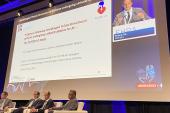ADVENT: Pulsed-Field Ablation for Paroxysmal AF Performs Well vs Thermal Systems
Noninferior safety and efficacy in the pivotal trial were accompanied by faster procedural times.

AMSTERDAM, the Netherlands—For patients with paroxysmal atrial fibrillation (AF), a pulsed-field ablation (PFA) system fared well versus conventional radiofrequency or cryoballoon ablation modalities in the pivotal ADVENT trial, the first randomized evaluation of the burgeoning technology.
In the hands of operators experienced with thermal ablation techniques, but not PFA, the Farapulse system (Boston Scientific) provided noninferior outcomes in terms of the primary efficacy and safety endpoints through 1 year of follow-up, Vivek Reddy, MD (Icahn School of Medicine at Mount Sinai, New York, NY), reported here at the European Society of Cardiology Congress 2023.
In addition, the findings—published simultaneously online in the New England Journal of Medicine—show there was less pulmonary vein narrowing with PFA, which was associated with shorter total procedure and ablation times, but longer fluoroscopy time, compared with radiofrequency and cryoballoon ablation.
“There are reasons to be excited about pulsed-field ablation,” Reddy said during a discussion after his presentation, He noted that this was the first experience with PFA for most operators. “This is a new technology that has important safety benefits—patients don’t have to worry about the possibility, albeit rare, of atrioesophageal fistula and other problems—that is faster, [and] that gives you at least the same efficacy,” he said.
The Pivotal ADVENT Trial
Multiple studies have shown that catheter ablation with either radiofrequency or cryoballoon ablation systems is a safe and effective treatment for patients with paroxysmal AF, Reddy said. But these types of energy have the potential to spread into tissues surrounding the myocardium and damage structures like the esophagus and the phrenic nerve.
PFA—which works by delivering very short, high-energy electrical pulses that punch holes in cell membranes—appears to be relatively specific to myocardial tissue. That raises the possibility that the technique will limit collateral damage compared with thermal ablation technologies.
Previous nonrandomized studies have suggested that various PFA systems are safe and effective, but ADVENT—with the Farapulse system—is the first randomized trial in this area. The single-blind trial, conducted at 30 centers with 65 operators, enrolled patients 75 or younger who had paroxysmal AF and who had failed at least one class I-IV antiarrhythmic drug. There was an 80-patient roll-in phase to allow operators to become comfortable with the technology followed by a randomized phase with 607 patients (mean age roughly 62 years; 35% women).
Patients were randomized to PFA or conventional ablation with radiofrequency or cryoballoon systems. Each center was assigned a thermal ablation modality for the control group, and ultimately, 55% of those patients were treated with radiofrequency ablation, and the rest cryoballoon ablation.
This is a new technology that has important safety benefits—patients don’t have to worry about the possibility, albeit rare, of atrioesophageal fistula and other problems—that is faster, [and] that gives you at least the same efficacy. Vivek Reddy
Acute success of pulmonary vein isolation was high in both groups—99.6% with PFA and 99.8% with thermal ablation. Procedures were more efficient with PFA, with shorter mean times for the total procedure (106 vs 123 min), left atrial dwell time (59 vs 84 min), and ablation time (29 vs 50 min). Fluoroscopy time, on the other hand, was longer in the PFA arm (mean 21 v 14 min).
“The difference in fluoroscopy time is probably related to the ubiquitous use of nonfluoroscopic electroanatomical mapping systems with radiofrequency ablation,” Reddy et al write. “Operator experience has been shown to reduce fluoroscopy exposure during pulsed-field ablation, and with the incorporation of these mapping systems into future pulsed-field ablation platforms, fluoroscopy use may be further decreased.”
The investigators used Bayesian statistical methods to evaluate outcomes. The primary efficacy endpoint was freedom from a composite of initial procedural failure, documented atrial tachyarrhythmia after a 3-month blanking period, antiarrhythmic drug use, cardioversion, or repeat ablation. At 1 year, this was met by an estimated 73.3% of patients in the PFA arm and 71.3% of patients in the control arm, with a posterior probability of noninferiority > 0.999.
Patients in both groups had a similar degree of improvement in quality of life.
Safety of PFA
The primary safety endpoint was a composite of acute and chronic device- and procedure-related serious adverse events, which occurred in six patients after PFA and four after thermal ablation (estimated incidence 2.1% vs 1.5%); the posterior probability of noninferiority was > 0.999.
One patient died during the trial, stemming from perforation related to manipulation of the catheter during PFA. “We believe that this death is spurious and not the tip of some iceberg related to pulsed-field ablation,” Reddy said, pointing to a prior registry study of data from 24 European centers, 77 operators, and 1,568 patients that recorded just one death associated with use of the Farapulse system.
There were no cases of pulmonary vein stenosis or atrioesophageal fistula in either group, and to explore the idea that PFA may have greater specificity for myocardial tissue than thermal ablation technologies, the investigators examined changes in pulmonary vein diameter 3 months after ablation using cardiac CT or MRI in a subset of patients. That analysis showed a significantly greater reduction in the caliber of the vein with thermal ablation (12% vs 0.9%).
The researchers also performed brain MRIs 48 hours after ablation in a subset of patients to look for silent cerebral lesions, which were found in three of 33 patients in the PFA arm, but none of the 37 patients examined in the control group, based on core lab adjudication.
‘Disappointing’ Results?
Serving as the discussant following Reddy’s presentation, Samuel Kiil Sørensen, MD (Gentofte Hospital, Copenhagen, Denmark), reviewed the evidence that existed for PFA before ADVENT. He noted that expectations were high after early studies indicated a high rate of durable pulmonary vein isolation with the new technology, carrying the potential for increased efficacy and safety.
Those initial studies showed, however, that among patients who returned for repeat ablation due to symptomatic recurrences, the rate of renewed pulmonary vein conduction was “unexpectedly high,” raising questions about the durability of the ablations, Sørensen said.
In terms of efficacy, large observational studies of PFA—including MANIFEST-PF and EU-PORIA—indicated higher rates of freedom from atrial tachyarrhythmia recurrence compared with patients treated with thermal ablation, although a nonrandomized comparison of ablation types did not show a difference.
On that background, Sørensen commended the ADVENT investigators for performing the first randomized comparison of PFA and thermal ablation, demonstrating similar efficacy.
On the safety side, both prior studies and ADVENT show very low rates—or no cases—of events like atrioesophageal fistula, pulmonary vein stenosis, persistent phrenic nerve palsy, and cardiac tamponade. Sørensen said there have been concerns about tamponade with PFA in the past but noted that large-scale cohort studies indicate similar rates compared with thermal ablation.
He also touched on procedural times, which—though shorter with PFA versus thermal ablation in ADVENT—were longer in the trial compared with prior experiences with the technique.
“So are these results disappointing?” Sørensen asked. “I think at least a few years ago many of us had the hopes for more.”
Even so, he said, it’s possible that there’s potential with PFA that is yet to be realized. This is first-generation technology being compared with thermal modalities that have been developed for decades, and operators have only just begun accumulating experience with the technology, he noted.
And, Sørensen concluded, “while speed does not take priority over safety or efficacy, [PFA] may enable us to treat more patients in a time of increased demand for AF ablation.”
Outlook for PFA
ADVENT will be used to support regulatory approval of the Farapulse system in the United States, where there are currently no PFA systems available, said Reddy; the device has already received CE Mark approval in Europe.
Regarding the outlook for PFA moving forward, Reddy said he’s “quite optimistic.”
“The ease of use of the technology in pulsed-field—and not necessarily just this technology, but pulsed-field in general—is really qualitatively different than what we’re used to,” he said. “So I think for all those reasons . . . things are quite favorable.”
From his perspective as an interventional cardiologist who does not perform AF ablations, Manesh Patel, MD (Duke Clinical Research Institute, Durham, NC), said that it’s good to have additional device options, but how PFA compares with thermal modalities, especially in terms of safety, ultimately will require larger, longer-term studies.
As for how PFA will be adopted if and when it’s approved in the US, Patel, a member of the American Heart Association’s national board of directors, said, “My sense is, in general, things that allow you to perform procedures as good and at least as safe, and make you take care of a patient faster, usually win out if you can reproducibly do that.”
Todd Neale is the Associate News Editor for TCTMD and a Senior Medical Journalist. He got his start in journalism at …
Read Full BioSources
Reddy VY, Gerstenfeld EP, Natale A, et al. Pulsed field or conventional thermal ablation for paroxysmal atrial fibrillation. N Engl J Med. 2023;Epub ahead of print.
Disclosures
- ADVENT was funded by Farapulse (later acquired by Boston Scientific).
- Reddy reports consulting for Abbott Vascular, AtriAN, Biosense Webster, Biostar Ventures, BioTel Heart – Philips, Biotronik, Boston Scientific, Cairdac, CardioFocus, Cardionomic, Coremap, Corvia Medical, Farapulse-Boston Scientific, Medtronic, Novartis, Novo Nordisk, Philips, ReCor Medical, and W. L. Gore & Associates; holding stock options in Ablacon, Acutus Medical, Affera, Anumana, APN Health, Aquaheart, Autonomix, Axon Therapies, Backbeat, Biosig, Cardiocare – Israel, CardioNXT/AFTx, Circa Scientific, Corisma, Dinova-Hangzhou DiNovA EP Technology, East End Medical, EP Dynamics, EP Frontiers, EpiEP, Epix Therapeutics, Eximo, Field Medical, Fire1, Focused Therapeutics, Heart Repair Technologies, Impulse Dynamics, Intershunt, Javelin, Kardium, Keystone Heart, Laminar, LuxMed, Medlumics, Middlepeak, Neutrace, Nuvera, Oracle Health, Pulse Biosciences, Restore Medical, Sirona Medical, and Valcare; and having stock in Affera, Biostar Ventures, Farapulse-Boston Scientific, Manual Surgical Sciences, Newpace, Nyra Medical, SoundCath, Surecor, Vizaramed.
- Sørensen reports research grants from Biosense Webster and Medtronic.





Comments